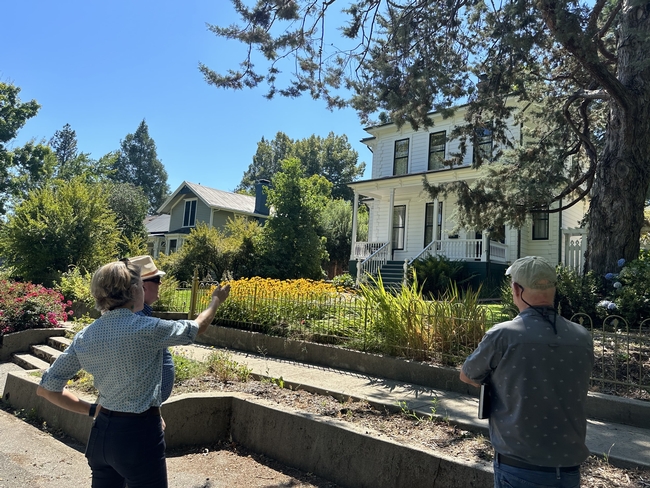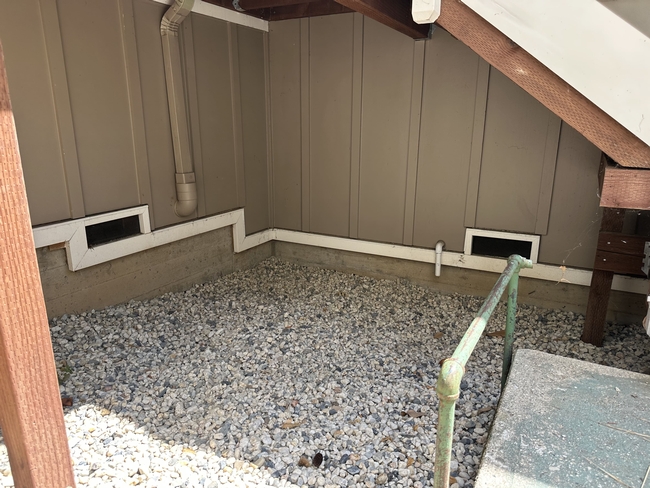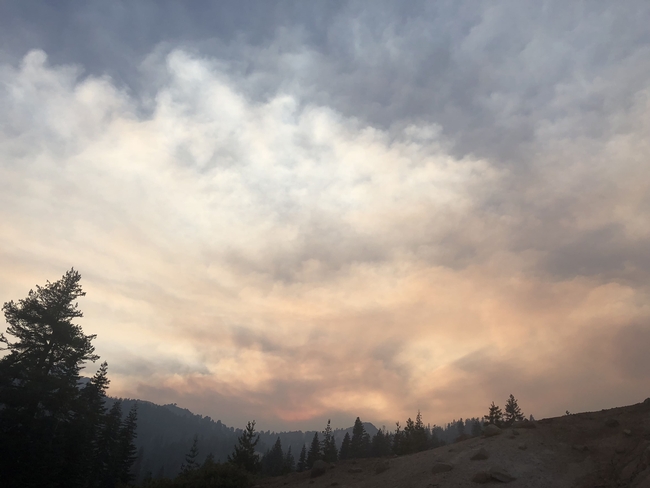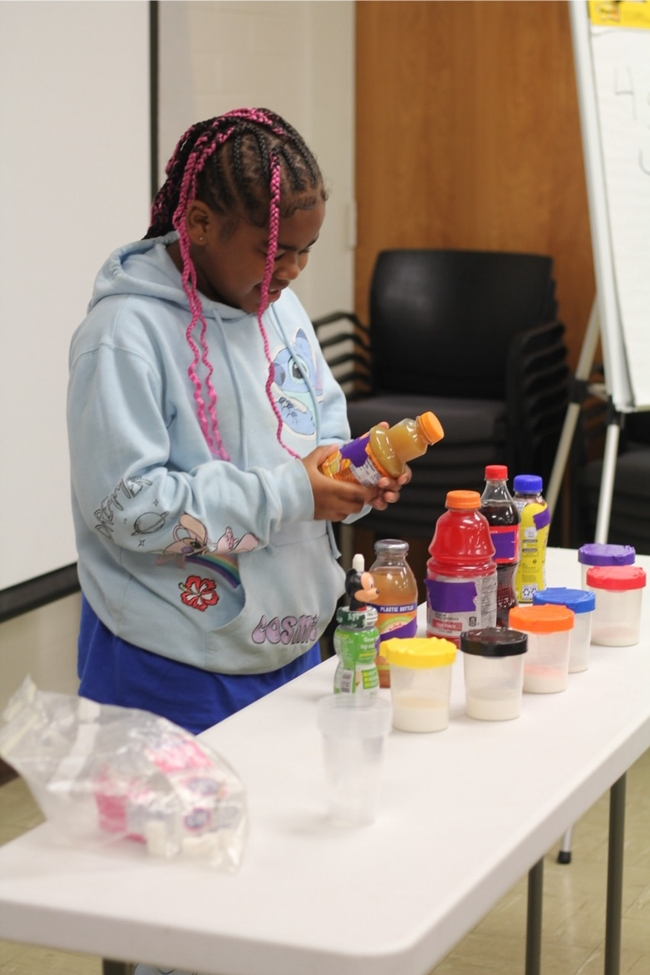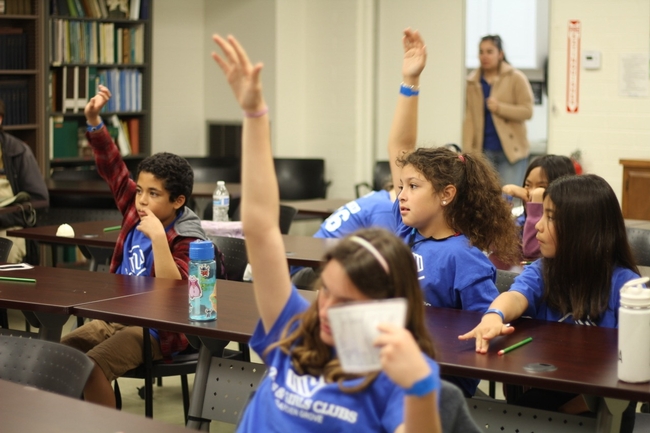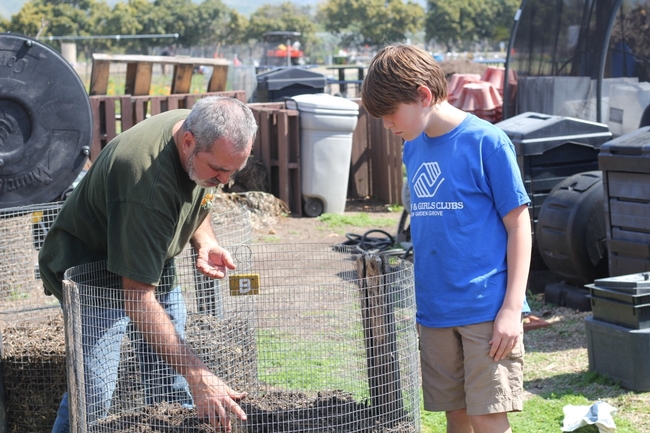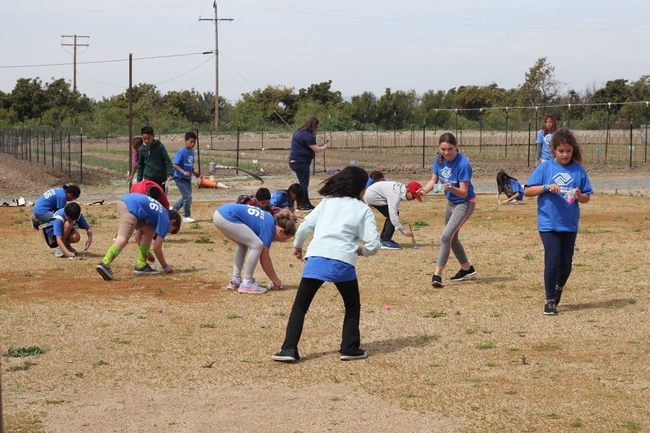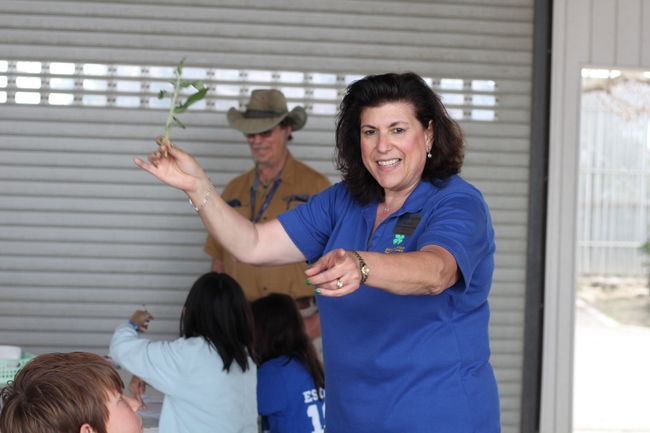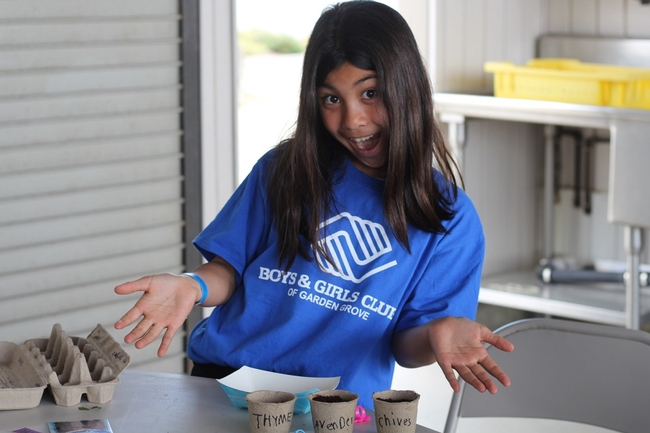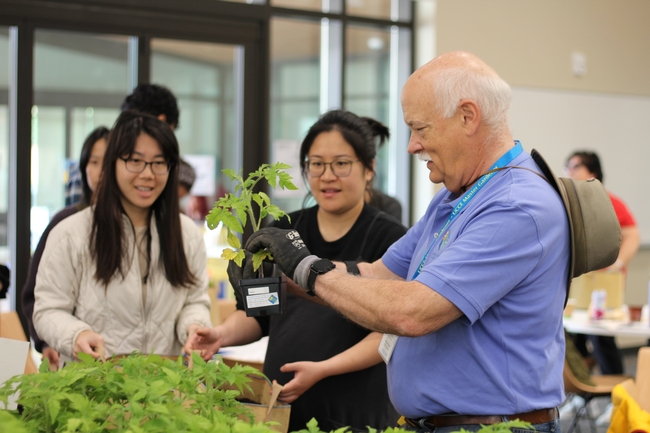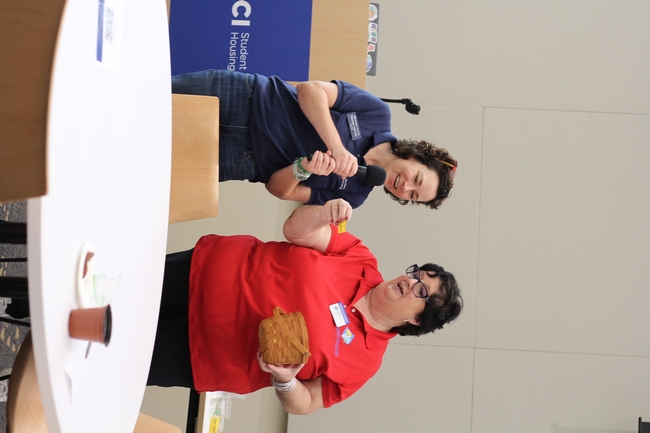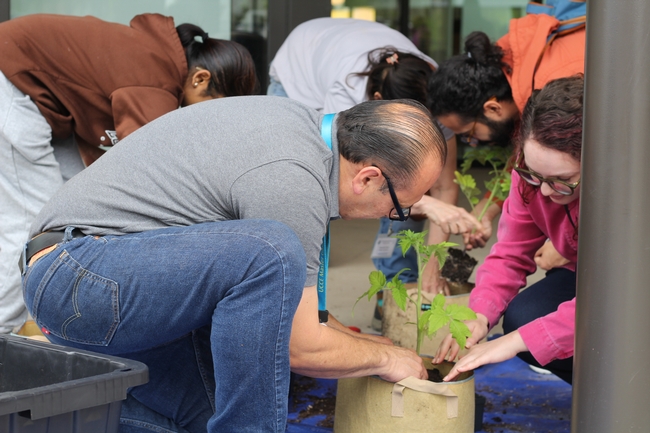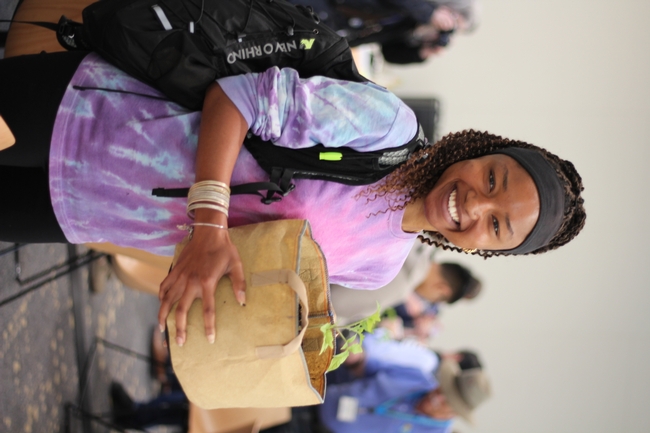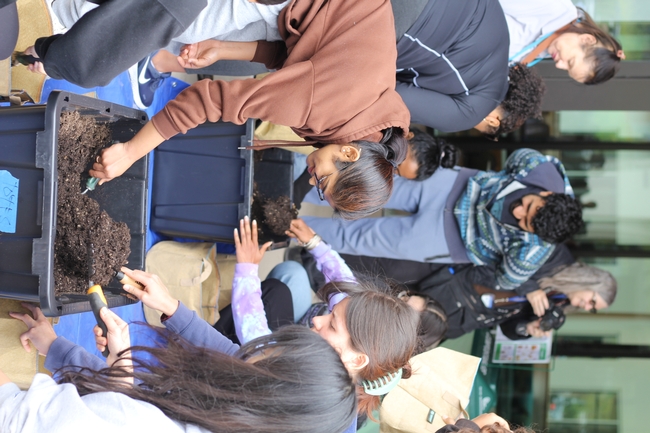Posts Tagged: garden
UC Master Gardeners equip Orange County’s Spanish-speaking community to garden on a budget
Since joining the University of California Master Gardeners of Orange County in 2022, Ana Peeks has been on a mission to share all that gardening has to offer, especially for the Latino community in her neighborhood.
“We've got to empower our Spanish-speaking community. They're one of the most vulnerable when it comes to food insecurity,” said Peeks. In partnership with Heather Hafner, a fellow UC Master Gardener, and the First Christian Church of Orange in Orange County, Peeks organized an opportunity for community members to learn introductory gardening in Spanish.
Every Tuesday for six consecutive weeks, 14 participants gathered in a conference room at the church. The course uses Seed to Supper, a program that was developed by Oregon State University Extension to teach food insecure communities how to grow their own food on a budget.
“The great thing about the Master Gardener community is that it stretches across the entire country, and we are able to draw upon fantastic programs and curricula from our partner organizations,” said Randy Musser, UC Master Gardener program coordinator for Orange County. UC Master Gardeners are supported statewide by UC Agriculture and Natural Resources.
Hafner, who has waited for the Seed to Supper program to be available for public use since 2019, completed the required facilitator training by OSU and was given access to the curriculum earlier this year. After learning that Peeks, a first-year UC Master Gardener, wanted to teach gardening to her church community but wasn't sure how to get started, Hafner jumped at the chance to collaborate.
Currently available in English and Spanish, the Seed to Supper curriculum is also customizable, said LeAnn Locher, OSU Master Gardener outreach coordinator.
“Even though it was created based on Oregon's climate, you can certainly adjust the curriculum to suit other growing conditions, including Southern California,” Locher added.
Together, Peeks and Hafner modified the program to suit the needs of the Orange County community, particularly which vegetables to plant during the different seasons.
Over the six weeks, the participants learned about topics such as soil health, fertilization and how to seed plants. The Great Park, a public park in Irvine, donated thousands of seed packets for a variety of fruits and vegetables.
Although she is always encouraging participants to expand their palates by growing new and different fruits and vegetables, Peeks also understands the importance of growing food that they typically consume and are familiar with. The participants provided a list of seasonal vegetables that they wanted to grow, mostly jalapeños, tomatoes, squash, melon and lettuce.
Because space in the home is a limitation for many, the course included lessons on vertical versus horizontal planting, as well as container gardening.
Program organizers removed barriers to participation
Several of the participants shared that the course has had an impact on their family. “I have more confidence that l can cook with what I learned from the course. I now know that I have to make good food choices for my family,” said Martha Montiel.
In addition to cooking the food they grow, participants said that gardening has created an opportunity to unite family and friends.
During class, Peeks instructs in Spanish and Hafner offers support in English, which Peeks then translates. While language is a barrier that both UC Master Gardeners were prepared to address, childcare was also top of mind. During class, on the opposite side of the conference room, you will see children watching a movie so their mothers, a majority of the participants, can be fully engaged in Seed to Supper.
Peeks was also mindful about transportation to and from class. Since many of the participants were already commuting to First Christian Church of Orange on Tuesdays for their food distribution program, it was convenient to host the class before the food distribution center opened to the public.
After receiving their certificates of completion, Peeks said she observed participants exchange vegetable planting experiences and give regular updates on their crop's progress. “Some participants are sharing their crops, gardening experiences and what they have learned with their friends and neighbors, too,” Peeks added.
Like Montiel, Amy Correa said that after taking the course, she assesses food before she buys it. “I look at the produce, read the labels, see if it's organic and where it was grown,” said Correa, adding that the course has motivated her to make healthier choices for her and her family.
One of the challenges that remains for Peeks and Hafner, however, is the cost of supplies. Hafner and her husband have donated large pots and soil to help participants get their gardens started, but both UC Master Gardeners envision participants having access to more tools like gloves, trowels, pots of various sizes and pruning shears.
“Extending information and sharing knowledge is the most important thing about these classes. But our impact can be so much greater when we're able to provide everything they need to get started. This includes tools,” Hafner said, noting that doing so aligns with their effort to remove barriers that hinder a participant's success in the program.
If you would like to donate to the UC Master Gardeners of Orange County, please do so here: https://donate.ucanr.edu/?program=UC_Master_Gardener_Program&county=Orange.
UC Master Gardeners of Imperial County grow from Mexican, Latino roots
First program of its kind in area establishes free seed library, community garden
One of the many things that make University of California Cooperative Extension in Imperial County unique is its close proximity to the U.S.-Mexico border. Its geographic location, with a border town called “La Frontera” by locals, infuses the UC Master Gardener Program in this area with intercultural knowledge.
In 2022, UCCE launched its first UC Master Gardener Program in the county and has maintained a cohort of 20 participants since then. Kristian Salgado, the program's first coordinator, said the volunteers offer a range of skills to the gardening community.
“The clientele that our volunteers serve tend to be individuals who have gained their gardening knowledge and experience from tending to plants in their homeland of Mexico,” said Salgado. The volunteer UC Master Gardeners of Imperial County reflect the region's predominantly Latino demographic, making it easier for volunteers to connect with their clientele.
“Nopales, chiles, citrus…residents in this region know how to take care of these plants. They've done it all their life. But when you have a program like the UC Master Gardener Program, you can use science to explain why their practices worked all these years,” said Salgado.
According to Salgado, the UC Master Gardener Program can be perceived as too academic for some residents. “It's not a bad thing, but I had to digest the information myself, even the UC Master Gardeners, and figure out how to deliver it in a way that was relevant to everyone,” she added.
As a starting point, Salgado used English and Spanish materials from neighboring counties like “A Garden of Words/Un jardín de palabras”, developed by the UC Master Gardener Program of Los Angeles County.
One method that helped engage volunteers and residents during classes was the use of culturally significant seeds like chiltepin peppers – seeds that Salgado deems a “must-have” if you are a gardener of Mexican heritage.
“When we focused on plant propagation, the volunteers that I worked with agreed that we should propagate plants that our residents were familiar with and use in their everyday cooking,” Salgado explained.
This same approach was employed at the free seed library and demonstration garden – both established and maintained by the UC Master Gardener volunteers at the City of Imperial Public Library. During the warm season you can find Roselle (Hibiscus sabdariffa L.), known to make agua de jamaica, in the seed library – something you won't easily find in grocery stores. In the demonstration garden during the summer, you'll notice a variety of peppers such as chile güero, jalapeño, serrano and habanero.
As the UC Master Gardener coordinator for Imperial County for the last two years, Salgado has focused her leadership on establishing a program that would generate opportunities for UC Master Gardener volunteers to create projects that are reflective of their interests, align with the program's mission and serve all residents in the county. The demonstration garden, which is the first community garden established in the city of Imperial, is an outcome of Salgado's vision.
UC Master Gardener Program reflects, connects community
Eliza Barajas, UC Master Gardener of Imperial County, who works at the library during the week and has witnessed the impact of the garden, said it gives her a sense of pride. “I moved to the [Imperial] Valley a year ago and I was looking for a way to connect with the community. I couldn't have asked for a better program to do that, and I'm so proud to say that I'm a part of the very first cohort in Imperial County,” Barajas shared.
Salgado praised Barajas for her enthusiasm in the program and noted her excellent ability to speak Spanish. “I love the way Eliza flows from English to Spanish. It's effortless! And it comes in handy when we're doing community events and need to cater to our Spanish and English speakers,” said Salgado.
Since the program came to fruition, Salgado has played a pivotal role in the program's progress. Reflecting on why she accepted the role of UC Master Gardener coordinator for Imperial County, Salgado said that the role was a culmination of everything she studied in school and cares deeply about.
While attending California State Polytechnic University, Humboldt, Salgado earned a master's degree in social science focused on the environment and community. She studied the intersections of food insecurity, the agricultural industry and health inequities, and how they specifically impact the Latino community.
Growing up and currently living in Calexico, Salgado questions why her community is food insecure. “Imperial is the ‘salad bowl' of the nation. We export a variety of fresh fruit and veggies all year long. How is it that our community doesn't have enough access to the healthy food it produces?” she asked.
Food security is one concern that Salgado envisions the UC Master Gardener Program addressing through its seed library, community garden and gardening classes.
Following graduate school, Salgado moved back home and joined former classmate and UCCE colleague, Chris Wong, in establishing the first farmer's market in Calexico in 2013. Wong encouraged Salgado to apply her new knowledge and skills at UCCE Imperial County, where she began working as a climate-smart agriculture community education specialist in 2019, supporting growers with grant writing.
“I realized early on that there was a lot of divestment in the community, and I didn't understand why,” she said, adding that she's still working to understand. Salgado's mother-in-law also continuously challenged her to think bigger. “My mom-in-law comes from the Chicano Movement. She's guided me into thinking more critically about the issues we face in our community and as Latinos.”
In September, Salgado began in a new role as the regional operations specialist for the UC Master Gardener Program statewide office, covering the Bay Area to Southern California regions. Salgado hopes to develop useful tools and resources to support coordinators' professional development, while integrating programmatic best practices centered on diversity, equity, inclusion and justice.
“The UC Master Gardeners are full of knowledge, and my education was motivated by identifying how Latinos can get a seat at the table. UC Master Gardeners easily become trusted sources in the community, and for Imperial County, this is how they get a seat at the table,” said Salgado.
Simple tasks make big difference in preparing for wildfire, smoke
UC ANR Fire Network compiles expert advice on preparedness, evacuation tasks
The explosive growth of the Park Fire in Northern California was fueled by recent, intense heat waves and extremely dry vegetation – conditions seen at many locations across the state.
Given the potential for wildfire and smoke impacts during what is expected to be a protracted “fire season,” California residents should think ahead and complete emergency preparations: https://ucanr.edu/sites/fire/Preparedness/.
“If you are concerned that you or someone you know could be affected by fire or smoke, now is the time to take simple steps to prepare,” said Yana Valachovic, University of California Cooperative Extension forest advisor for Humboldt and Del Norte counties.
Valachovic and other members of the UC Agriculture and Natural Resources Fire Network are urging community members to tackle small but significant tasks to minimize potential fire damage. Many of these tasks can be finished in a weekend, such as:
- Clean debris from your roof and gutters.
- Inspect the area around your home and nearby structures and remove all combustibles (dead grass, plants, woody mulch, stored wood, etc.) in the first 5 feet, including under decks and stairs.
- Inspect the foundation, under-eave, and gable-end vents for holes and damage; add a layer of finer metal-mesh screens (1/8” mesh) to the vents to prevent ember penetration.
- Inspect the garage door bottom seal to make sure embers can't blow under the door.
- Replace the first 5 feet of wooden fences that attach to buildings with a noncombustible panel or gate.
A recently published report, “Retrofitting a Home for Wildfire Resistance,” also can help residents prioritize the measures that are most cost-effective and fit their budget.
Six things to do, six hours before evacuation
As evacuation warnings are issued for local communities, there are six important things to do in advance of an actual evacuation order, according to Valachovic:
- Close windows, pet doors and skylights.
- Move inside patio cushions, brooms and door mats; tie open wooden gates that attach to the house or deck to prevent a fire from traveling from the fence to the house.
- Relocate the barbecue propane tank away from home.
- Stage buckets of water and garden hoses in visible locations.
- Dress for evacuation: cotton clothes, sturdy shoes, hat and face protection and leather gloves.
- Put your “go bag” in your vehicle.
The UC ANR Fire Network website also includes downloadable checklists – in English and Spanish – for your go bag (https://ucanr.edu/sites/fire/Safety/Evacuation/Preparing_a_Go-Bag/) and for a host of important pre-evacuation tasks for your household, property, pets and livestock (https://ucanr.edu/sites/fire/Safety/Evacuation/).
“We want communities to be wildfire-prepared – not scared,” Valachovic emphasized.
Smoke exposure a significant public health concern
Hazardous smoke can blanket wide swaths of California – and much of the Western U.S. – during ongoing wildfire events. A primer on harmful health effects, a list of tips for reducing smoke exposure, and other resources and links can be found on the UC ANR Fire Network site: https://ucanr.edu/sites/fire/Safety/Air_Quality_and_Smoke/.
“If there's smoke in the forecast for the next few days, I would keep an eye on my local air quality at fire.airnow.gov,” said Katie Low, statewide coordinator for UC ANR's Fire Network. “And if the AQI – Air Quality Index – is high, I would limit my outdoor activity, wear an N95 mask if I do go outside, and run my air purifier.”
For instructions on making a DIY air cleaner, creating a “clean air space” in your home and fitting an N95 mask properly, visit the California Air Resources Board's “Smoke Ready California” page: https://ww2.arb.ca.gov/smokereadyca.
Another useful tool is the crowd-sourced #FireMappers fire activity map – powered by the National Alliance for Public Safety GIS Foundation, GISCorps, and CEDR Digital Corps – accessible through the UC ANR Fire Network site: https://ucanr.edu/sites/fire/Safety/Current/.
4-H, Boys and Girls Club, UCCE partner to inspire Orange County kids
Small containers with varying levels of sugar sit next to a row of beverages, including water, fruit juices, soda, a sports drink and chocolate milk. Trying to match each container with the beverage that contains its corresponding amount of sugar, Amore, a fourth grader, reads the nutrition label on the orange juice bottle. “What does the bottle say?” asked a student in the audience, attempting to help Amore.
Life skills such as how to read a nutrition label are representative of learning that youth can expect when joining 4-H, a nationwide program focused on empowering kids ages 5 to 18. 4-H offers experiential learning opportunities ranging from STEM (Science, Technology, Engineering and Mathematics) and healthy living to civic engagement and leadership.
To expand its reach and make their program more accessible, 4-H launched a digital learning platform called CLOVER by 4-H that offers content tailored for three types of users: learner, parent and educator. As the platform grows in popularity, 4-H is eager to identify best practices in engaging new users to join the platform and retain their interest.
More than 250 free 4-H lessons
In California, 4-H programs are overseen by University of California Agriculture and Natural Resources. Given its successful contributions to statewide initiatives in the past, 4-H in Orange County, administered through the local UC Cooperative Extension office, was one of three counties selected to participate in a CLOVER pilot project in conjunction with the National 4-H Council. With more than 250 4-H lessons available online at no cost, the pilot project aims to introduce its users to 4-H.
To generate interest, 4-H in Orange County is leveraging connections to local Boys and Girls Clubs. In March, they hosted more than 20 kids from the Boys and Girls Club of Garden Grove (BGCGG) – including Amore – for a day of learning and exploration at the UC South Coast Research and Extension Center in Irvine, where the 4-H program for Orange County is based.
Rita Jakel, community education specialist and program coordinator for 4-H of Orange County, said that partnering with BGCGG will, hopefully, inspire its members to join their local 4-H club.
“The youth created a CLOVER account before engaging in eight CLOVER lessons taught by the staff at the Boys and Girls Club during their weeklong Spring Break Day Camp,” said Jakel, noting that the participants were introduced to 4-H before arriving to South Coast REC for in-person activities.
Interactive nutrition and gardening lessons
During their visit, the participants engaged in a typical day of 4-H lessons featuring presentations from the local Expanded Food and Nutrition Education Program (EFNEP) and UC Master Gardener volunteers. Jakel then wrapped up with interactive sessions on animal adaptations—understanding the challenges animals face in gathering food—as well as lessons on growing and cooking with herbs.
“One of the most rewarding aspects of working with young people is the opportunity to creatively educate them on various subjects, ensuring that learning is both enjoyable and engaging,” said Javier Miramontes, community nutrition and health supervisor for EFNEP in Orange and Los Angeles counties, who started the day off with the lesson on nutrition labels.
Miramontes visually explained how much sugar is found in various beverages and then challenged the students to do so on their own. “It's important to me that all students participate, as engagement is key at their age, not only for inclusivity but also to maintain their focus,” he said. Miramontes concluded with a review of his lesson and was pleased that most of the class demonstrated a solid understanding of the key topics.
While the intention of CLOVER is to introduce users to 4-H in hopes that they would want to become members of their local clubs, Jakel believes that participating through CLOVER could be just as effective, if not more. “We're testing out the idea of bringing kids to our facility for typical 4-H programming. If they like it, our hope is that they'll sign up on CLOVER and gain access to our educational approach there,” said Jakel.
4-H in person and online
The goal is to give youth options so that the 4-H experience, whether in person or online, does not feel out of reach.
When discussing their collaboration, Jakel said that the BGCGG staff would continue to support interested kids and their families with CLOVER registration. The staff also agreed to conduct programming based on the digital platform at their facility to continue exposing BGCGG members to all that 4-H has to offer, which they have already reported as easy to implement and engaging among the youth.
During their time in the garden, members learned about vermiculture and how worms are essential for compost. Mary Nguyen, STEM specialist for BGCGG, said that she enjoyed watching the youth light up when they are playing in the dirt and learning about how fruits can be combined to produce new generations. To wrap up their visit to the garden, the group received a small worm box to use for their own school garden.
“I hope that more fun field trips – and hands-on activities involving research that youth can participate in – will come from our partnership with South Coast REC and 4-H,” Nguyen said.
Field trips to see, touch, smell and taste
From a UC Master Gardener's perspective, the youth were extremely interested in learning about everything and asked many questions. “I loved their curiosity,” said UC Master Gardener volunteer Laura Holly, who helped with the garden demonstration and tour of UC South Coast Research and Extension Center. “They wanted to know why certain pipes were painted purple (to indicate reclaimed water), about the windmills and how avocado trees are grafted.”
“More children would benefit from seeing how the trees that produce the fruit they eat grow,” Holly added.
Hannah, a fourth grader, said that she loved the lesson on herbs that Jakel led before the participants boarded the bus to return home. All members got to see, touch, smell and taste four different herbs before planting their own to take home. “I had a lot of fun. I think if I had to grow one thing, it would be chives. They actually taste really good,” Hannah said.
Amore, who knew what lavender smelled like before, had never seen a lavender plant. “My mom loves lavender, but I didn't know this is what it looks like. I planted some lavender to take home for her,” she said.
The partnership with BGCGG is one of many that Jakel hopes to foster in Orange County, in addition to uniting UCCE programs to enrich the learning experience for youth who visit South Coast REC and those enrolled in the 4-H program. Her goal, in line with that of CLOVER, is to make 4-H programming more accessible for the youth, parents and educators alike.
To learn more about 4-H in Orange County, visit https://oc4h.org/.
UC Master Gardeners empower college students to garden for mental wellness
Although training is required to become a University of California Master Gardener, the benefits of gardening can be experienced by anyone and everyone.
“As long as you're willing to get your hands dirty,” said Laurie Menosky, a UC Master Gardener volunteer in Orange County, “you can learn to grow all sorts of things.”
In early April, Menosky partnered with ETN Medical Infusion (a clinic in Orange County) and the Sustainability Program for Student Housing at UC Irvine to teach students how to grow tomatoes. Menosky welcomed all in attendance, including families with toddlers who seemed fascinated by the 60 tomato plants atop one of the tables in the room.
The UC Master Gardener Program is a part of UC Agriculture and Natural Resources. During her presentation, Menosky taught participants how to choose varieties that fit their taste and growing environment, how to cultivate a thriving environment, and how to control pests and diseases using integrated pest management practices.
“We have 16,000 residents at UCI and sustainability is one of our values. One of the ways we engage students is through on-campus gardens,” said Rachel Harvey, sustainability program manager for UCI Student Housing and a UC Master Gardener volunteer in Orange County.
UC Irvine has one teaching garden reserved for undergraduate learning, and three gardens operated and maintained by graduate students. “I was on the waiting list for a garden plot for a while, but it was totally worth the wait,” said Johanna Rinaman, a fifth-year Ph.D. student studying physical chemistry.
While the highlight of the event for many people was the opportunity to take a tomato plant home, another important takeaway was how gardening can be a good activity for your mental health. Sarah Nghiem, family medicine specialist at ETN Medical Infusion, who worked closely with Menosky, was instrumental in developing the mental health content for the day, encouraging attendees to attempt gardening with a mental health perspective.
Nghiem and her team received funding from the Orange County Health Care Agency through the Mental Health Services Act to work with transitional aged students (15-24 years-old) on understanding the importance of mental health, which led to the collaboration between UC Irvine, her alma mater, and the UC Master Gardeners of Orange County.
“I didn't do any gardening during the winter, and I felt a lot more anxious and depressed during that time,” Rinaman said. “I know gardening improves mental health because I've immediately felt a difference whenever I spend time with plants.”
Rinaman, whose father taught her a lot of what she knows about gardening, said that having access to a 4 feet by 6 feet plot to grow her own food is one of the many things she loves about UC Irvine.
Like Rinaman, Menosky turns to gardening to decompress, especially during the long days of summer. Teaching others about the physical and mental benefits of gardening gives her an opportunity to share her experience and, hopefully, help others find new ways to manage stress.
“We often have attendees come back years later telling us how our information has helped them and how much more they are enjoying their time in their gardens,” she said.
To conclude her presentation, Menosky instructed participants to line up for their own tomato plant. Attendees took their plants outside to transfer them from a small pot to a grow bag – a type of container that helps root structure development.
Cassie Ekwego, a third-year transfer student studying civil engineering, couldn't hide her excitement after carefully lifting her plant. “I don't think I realized how attentive you need to be when working with plants,” said Ekwego, reflecting on what she learned from Menosky's presentation.
Now that she has her own plant to care for in her own home, Ekwego is eager to put her new knowledge to the test. “I love tomatoes, but this is going to be a huge responsibility for me,” she said.
Randy Musser, UC Master Gardener program coordinator for Orange County, said that while he enjoys talking to avid gardeners, bringing gardening to new people in the community is special to him. “This tomato workshop is particularly exciting for me because it is an opportunity for the UC Master Gardeners to grow our connection to UCI and young people just starting off on their gardening journey,” said Musser.
With a generous contribution from UC Master Gardener volunteer Sheila Peterson, Musser was able to purchase enough supplies to help attendees, like Ekwego, jumpstart their gardening experience.
Students, whose stress levels can skyrocket throughout the school year, value opportunities to be outdoors, try something new and be in community. “The garden is a different type of classroom. It's a place where students can learn and experiment, hopefully in a way that reduces stress,” said Harvey of UCI Student Housing.
Ekwego, who tried gardening for the first time while volunteering at UC Irvine's teaching garden, is just one of the many students inspired by their experiences. “Gardening reminds me that it's OK to get my hands dirty,” Ekwego said.









